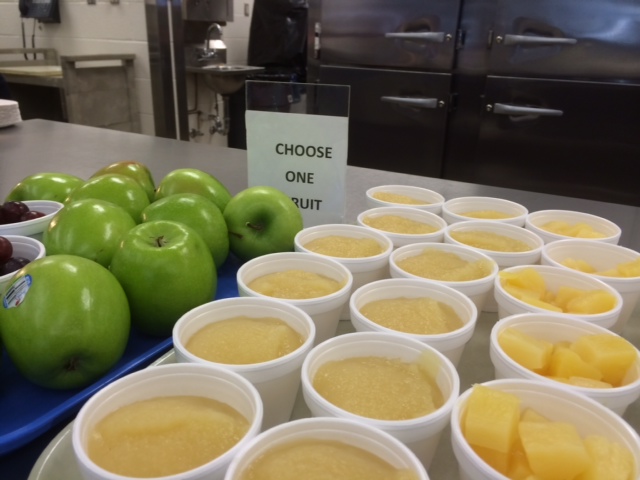You don’t expect to see a chef like Parker Bosley slicing up pizza in a school cafeteria.
“This is the first time I’ve been in a high school for quite a long time," he acknowledges.
The founder of Parker’s New American Bistro retired in 2006 and has been working ever since to help Ohio farmers find markets for what they grow. As chef-in-residence for Cleveland’s Fresh Fork Market farm-buying club, he’s come to Tallmadge High to show lunch ladies good ways to use farm-fresh local produce.
“For me, an advocate of many years in this wholesome food and food from the farm, etc., this is very encouraging that it is not impossible to bring real food, whole food, nutrient-dense food into a school. And we’re seeing here that students do respond to it much more than a lot of people predict.” into a school. And we’re seeing here that students do respond to it much more than a lot of people predict.”
Better in several ways
Ninth-grader Cameron Figueroa made a beeline to the cafeteria when the lunch bell rang.
“Bringing the farm to the school. It’s more natural than processed food and better for your body.”
But how does it taste? “A lot better.”
Jeff Ferguson is Tallmadge’s superintendent.
“I had the summer sensation and then also the meat-lover’s pizza. It’s awesome. Monday we had a phenomenal taco bar. The kids loved that. And yesterday was a wheatberry salad with feta. And then today, I came in and they’re getting the thumbs up so the feedback from
 the students. ... They really like the idea of knowing where this is coming from.” the students. ... They really like the idea of knowing where this is coming from.”
Farm-to-School Week is a pilot program developed by Pisanick Partners, a school-food consulting firm, and Fresh Fork founder Trevor Clatterbuck.
Fresh Fork picks up food from small farms and delivers weekly to more than 3,000 consumers.
Clatterbuck hopes to leverage his subscribers’ bulk buying power to make local food economical for schools, so they won’t have to rely as heavily on government commodities and big distributors.
He’s busy this lunch period stirring the béchamel sauce he and Parker Bosley came up with for their “Summer Sensation” pizza.
 Tracking down the ingredients Tracking down the ingredients
Its spelt crust was custom-made.
“A bakery called Frickaccio’s down in Fairview Park, they started with spelt flour that was freshly grown and milled down in Holmes County at a place called Stutzman’s. The milk, the flour and the butter, all local sources from Wayne and Holmes County. The spinach here’s from Middlefield. The tomatoes were harvested in the summertime, processed in Cleveland. And the cheese is from a creamery down in Wilmot, Ohio, off of U.S. 62.”
Transportation costs are less when food comes from nearby, but to make local food truly affordable for Tallmadge High, dietician Maureen Pisanick says they really had to sharpen their pencils. pencils.
“Trevor and I are working really hand-in-hand together. It’s kind of a balancing act of doing the plate cost of $1.20-$1.25 and all of the nutritional components that we’re trying to meet, to meet the national school meal requirements.”
Those have been stringent since rule changes in 2008. Fat is restricted to 30 percent of calories, and next year sodium restrictions are coming, too.
Plus, school cooks have tough customers to please. Pisanick says students want choices, so Farm-to-School week includes feedback through surveys and social networking.
“We have to really up our game here in school food service to really get them engaged in the process.”
The reaction from the toughest of critics
Ninth-grade athletes Jake Perrin and Nate Adolph put votes in for the pizza. They find they can stoke up on this kind of cafeteria fare and stay lean.
 “Fresh fruit and vegetables,” says Jake. “It’s like whole wheat bread and stuff like that.” “Fresh fruit and vegetables,” says Jake. “It’s like whole wheat bread and stuff like that.”
"The obesity thing has been a crisis lately," says Nate, “and they’re all trying to help us out.”
Twelfth-grader Chase Scherzinger has spent his entire academic life in Tallmadge schools, "and school lunches haven’t been wonderful. They’ve been kind of smaller portions, not really that healthy. I mean they’ve been trying to improve them, but not really doing the job.”
How has it been this week with the new approach? “It’s been really good. I mean the lunches have been good.”
Local economic benefits
And he likes supporting sustainable agriculture.
“Getting everything from local areas is really nice because it’s really like stimulating the economy.”
Tallmadge business manager Steve Wood says the popularity of Farm-to-School shows the concept could work.
“It does cost us a little bit more for the meals. But the more students get excited about it, the more meals that we sell, it enables us to cover our cost.”
Besides, says the superintendent, well-fed students learn better.
 “Sometimes you have to step back and ask, 'What’s really the additional cost in our students not performing at their best?' But if this helps along those lines then a little extra cost is really an investment.” “Sometimes you have to step back and ask, 'What’s really the additional cost in our students not performing at their best?' But if this helps along those lines then a little extra cost is really an investment.”
February’s Farm-to-School week in Tallmadge was Fresh Fork and Pisanick Partner’s second pilot project.
Hudson Middle School hosted a locally raised turkey dinner just before Thanksgiving.
The hope is to get more school systems involved as well as to teach the next generation the benefits of buying local.
And that’s this week’s Quick Bite. Next week, we’re all about rabbits: how to raise them for profit, and how to cook them, too. |